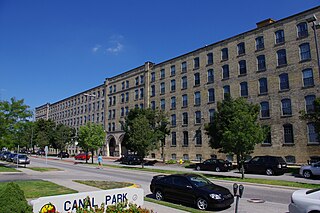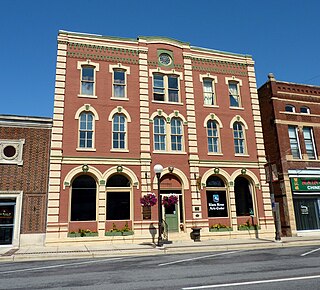
The Second Leiter Building, also known as the Leiter II Building, the Sears Building, One Congress Center, and Robert Morris Center, is located at the northeast corner of South State Street and East Ida B. Wells Drive in Chicago, Illinois. The building is not to be confused with the present Willis Tower, formerly the Sears Tower, constructed and owned by the famous nationwide mail-order firm Sears, Roebuck & Company. This landmark of the Chicago school of architecture gained fame for being one of the earliest commercial buildings constructed with a metal skeleton frame remaining in the United States.

The Cass–Davenport Historic District is a historic district containing four apartment buildings in Detroit, Michigan, roughly bounded by Cass Avenue, Davenport Street, and Martin Luther King, Jr. Boulevard. The district was listed on the National Register of Historic Places in 1997. The Milner Arms Apartments abuts, but is not within, the district.

The Kennedy-Worthington Blocks are three historic commercial and industrial buildings at 1585-1623 Main Street and 166-190 Worthington Street in downtown Springfield, Massachusetts. Built in the 1870s and 1880s, with a major restyling to two of them in 1912, the buildings were a major factor in the urban development of the area north of the city's traditional core. They were listed to the National Register of Historic Places in 1979.

The Produce Exchange Building is a historic commercial building at 194–206 Chestnut and 115–125 Lyman Street in downtown Springfield, Massachusetts. Built in 1899 and remodeled in 1926, it is one of the largest of Springfield's early 20th-century commercial buildings, used for many years as a wholesale produce market. It was listed on the National Register of Historic Places in 1983.

Berkey and Gay Furniture Company Factory is a manufacturing plant located at 940 Monroe Ave., NW in Grand Rapids, Michigan. It was listed on the National Register of Historic Places in 2000.

The Monroe Avenue Commercial Buildings, also known as the Monroe Block, is a historic district located along a block-and-a-half stretch at 16-118 Monroe Avenue in Detroit, Michigan, just off Woodward Avenue at the northern end of Campus Martius. The district was designated a Michigan State Historic Site in 1974 and listed on the National Register of Historic Places in 1975. The thirteen original buildings were built between 1852 and 1911 and ranged from two to five stories in height. The National Theatre, built in 1911, is the oldest surviving theatre in Detroit, a part of the city's original theatre district of the late 19th century, and the sole surviving structure from the original Monroe Avenue Commercial Buildings historic period.

The Lower Woodward Avenue Historic District, also known as Merchant's Row, is a mixed-use retail, commercial, and residential district in downtown Detroit, Michigan, located between Campus Martius Park and Grand Circus Park Historic District at 1201 through 1449 Woodward Avenue and 1400 through 1456 Woodward Avenue. The district was listed on the National Register of Historic Places in 1999.

The Masonic Temple in Cadillac, Michigan is a commercial building built in 1899. It is the earliest surviving fraternal building designed by the prolific architect Sidney Osgood. It was listed on the National Register of Historic Places in 1994.

The Renwick Building is a historic building located in downtown Davenport, Iowa, United States. It has been listed on the National Register of Historic Places since 1983, and on the Davenport Register of Historic Properties since 2000. In 2020 it was included as a contributing property in the Davenport Downtown Commercial Historic District. It is known locally for the large painted sign on the north side of the building depicting the Bix 7 Road Race.

The Grand Hotel is a historic hotel in New Ulm, Minnesota, United States. The private, commercial structure was placed on the National Register of Historic Places (NRHP) on June 21, 1990. The building is notable because of its association with the development of New Ulm's business district and as an example of Italianate architecture in a commercial building.

The Mathewson Block is a historic commercial building at 101 Main Street in the center of Lyndonville, Vermont. Built in 1869, it was the first brick commercial building erected in Lyndonville, which was founded in 1866. It was listed on the National Register of Historic Places in 1999.

Lagomarcino-Grupe Company, also known as Rand & Coolbaugh's Block, is a historic building located in the central business district of Burlington, Iowa, United States. It was individually listed on the National Register of Historic Places in 2013, and it was included as a contributing property in the Downtown Commercial Historic District in 2015.

The New Center Commercial Historic District is a commercial historic district located on Woodward Avenue between Baltimore Street and Grand Boulevard in Detroit, Michigan. It was listed on the National Register of Historic Places in 2016.

The Petoskey Downtown Historic District is a commercial historic district, roughly bounded by Rose, Division, Michigan, and Petoskey streets in Petoskey, Michigan. It was listed on the National Register of Historic Places in 1986.

The Aldrich Building is a historic building located at 98 Monroe Center, NW in Grand Rapids, Michigan. It has been listed on the National Register of Historic Places since November 12, 1982.

Nickels Arcade is a commercial building located at 326-330 South State Street in Ann Arbor, Michigan. It was listed on the National Register of Historic Places in 1987. The building is notable as perhaps the only remaining example in Michigan of a free-standing commercial arcade building of a type that was popularized by the Cleveland Arcade.

The Loraine Building, located at 124 East Fulton Street in Grand Rapids, Michigan, was constructed as an apartment building, and was later converted into office space. It was listed on the National Register of Historic Places in 1982.

The Ledyard Block Historic District is a group of seven adjacent, coherently designed, nineteenth century commercial structures located within a square block at 123-145 Ottawa Avenue and 104-124 Monroe Center, NW, in Grand Rapids, Michigan. The group of buildings was listed on the National Register of Historic Places in 1983.

The Peck Block is a commercial building located at 34-50 Monroe Center NW in Grand Rapids, Michigan. It was listed on the National Register of Historic Places in 2000. The building has been rehabilitated to house condos on the upper floors.

The American Box Board Company Headquarters and Factory is a former factory building located at 470 Market Avenue SW in Grand Rapids, Michigan. It was listed on the National Register of Historic Places in 2020.






















